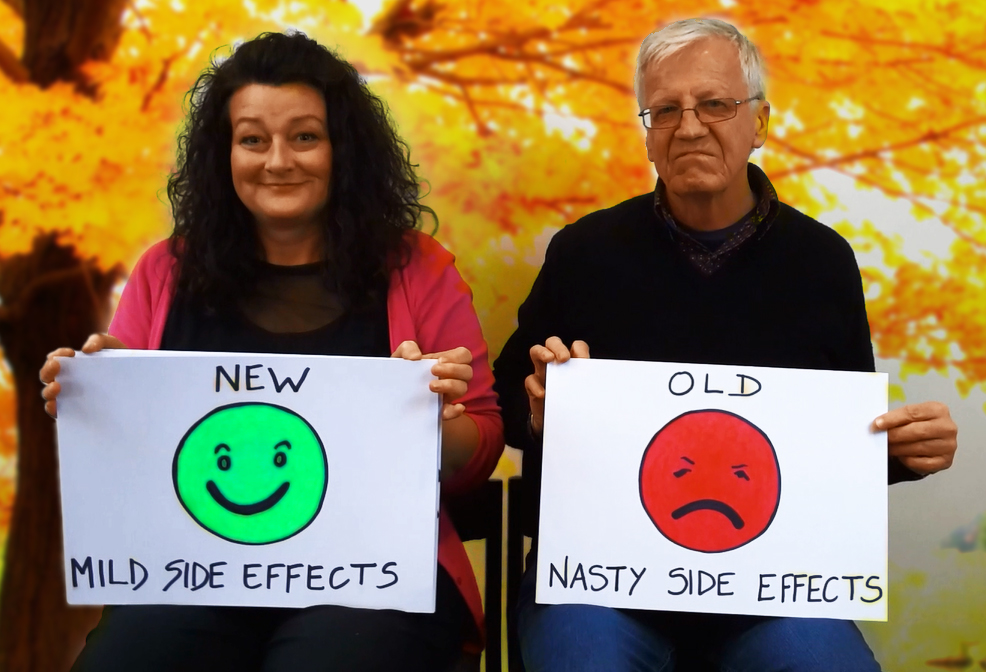As part of World Hepatitis Day, people all over the world were encouraged to investigate the new treatments now available for hepatitis C. These treatments are more effective, faster, easier to take and with much smaller side-effects than the treatments which were used up until early 2016.
However, all the excitement about the new treatments has obscured one thing: just how much hardship people had to go through before this year to treat their hepatitis C—hardship that quite frequently didn’t even end up in the virus being cleared.
(Compare the old and new treatments with Lisa and Fred of Hepatitis SA in this video.)
Until this year, hepatitis C treatment almost always consisted of “combination therapy”: a combination of pegylated interferon and ribavirin. The course of treatment was sometimes 24 weeks, but more usually 48 weeks. The interferon was self-injected once a week, and the ribavirin taken twice a day in capsule form.
Side effects from combination therapy could include nausea, depression, thyroid abnormalities, muscle aches, anaemia and hair loss. In addition, ribavirin is also associated with birth defects, so contraceptive use was essential for both men and women during and for a period after treatment—which could mean more than a year.
Without them and what they had to go through, there would not have been the impetus to develop new medications.
For some people, the physical and psychological side effects of combination therapy were overwhelming. Given that treatment could last for up to twelve months, some people found it hard or impossible to continue working or looking after their children, and many people experienced difficulties in their personal and professional lives.
And after all that, only an average of 60% of people cleared hepatitis C: about 80% of those with genotypes 2 or 3, but only 50% with the most common form, genotype 1.
Carol Bose was one of many people hit by combination therapy’s side-effects. “A main concern for the specialist at that time was that for some people treatment can cause suicidal thoughts, and it was highly recommended that there was support from a partner or family for the duration of the treatment,” she told Hepatitis SA Community News in 2014.
“[I was] drained all the time, as though I had just run a marathon—body aches and pains, headaches, some nausea, dry skin, dry mouth and hair loss. My hair started to thin so I got extensions, but it didn’t take long before they began to pull my hair out from the roots. I would spend most of my days lying on the sofa watching TV.
“I remember leaning against the sink at night while brushing my teeth because it was too tiring to stand for long. My house wasn’t very big but I would have to sit down and take a break when walking from one side to the other.”
Carol was lucky enough to have the treatments work for her (read more of her story here). Karan, one of Hepatitis SA’s Peer Educators, was not so lucky, though she still found the process empowering. “I had to pace myself, have days off to regain my strength. It wasn’t an easy road.”
After combination therapy failed her, Karan was accepted into a medical trial of the new treatments in 2013, which did succeed in clearing the virus (read more of her story here).
Penni, another Hepatitis SA Peer Educator, simply didn’t go on treatment because of the probable side-effects. “I simply cannot afford to give up my work. I work part-time, but I earn just enough not to be eligible for government assistance. If I had to cut my hours back, my income would drop significantly.” (Read more of her story here.)
One of the worst experiences was that of Kaz Dean, who documented her experiences with combination therapy in a video diary on Youtube (see the videos here).

“I began interferon and ribavirin treatment at the Royal Adelaide Hospital. I had a negative experience right from the start—any side-effects that have been mentioned, I experienced them, and then some! I even had blackouts or the opposite of blackouts, a kind of hallucination or false memory, where I swore to my partner that we had had a night out the night before, and though the memories were so real to me, he told me we had gone nowhere.
“I was mentally affected, and physically I couldn’t function. There were quite a few times where ambulances were called, due to my haemoglobin being so low: I kept passing out, and at one point had a fit at the doggy park, banging my head on the ground repeatedly (which I don’t remember, but my poor 12-year-old had to deal with it by asking someone for their mobile to ring an ambulance).
The outcome of that horror story was that no, I didn’t lose the virus, I and swore I would never go on the treatment again.
“In the end I was going to have a blood transfusion, which thankfully didn’t happen. During my treatment the blood test results had come back with the virus undetectable a few times, so I had hope, but in the end I was bedridden and had to stop the treatment 10 weeks early. The outcome of that horror story was that no, I didn’t lose the virus, I and swore I would never go on the treatment again.” (Read more of her story here.)
So as we celebrate the efficacy and relative ease of the new treatments for hepatitis C, with even more effective treatments still on the horizon, let’s not forget all the difficulties and obstacles faced by those who faced treatment in the past, and those who made the hard decision to decline the opportunity of being treated because of its harshness. Without them and what they had to go through, there would not have been the impetus to develop new medications.
